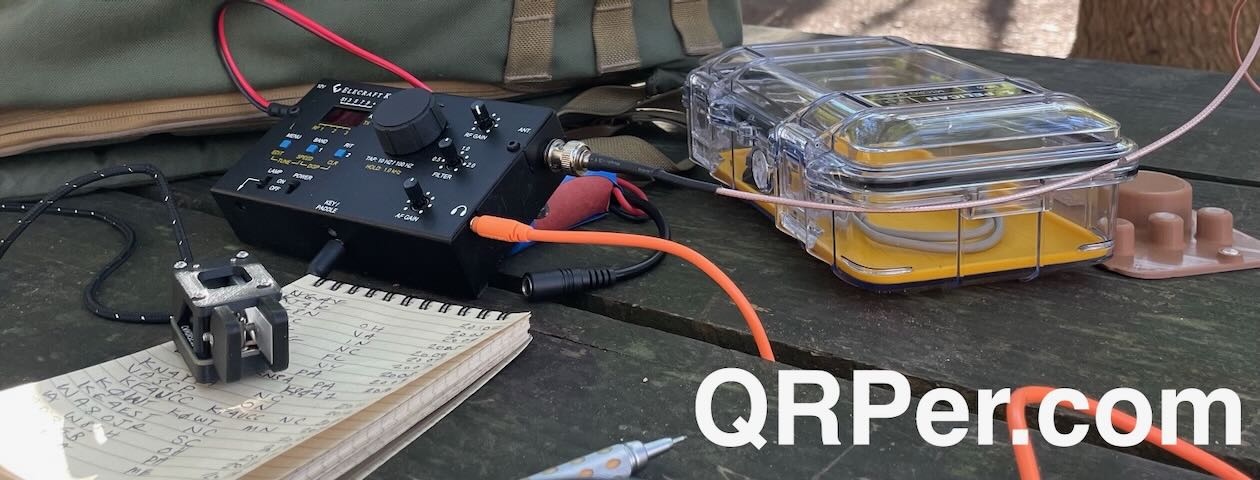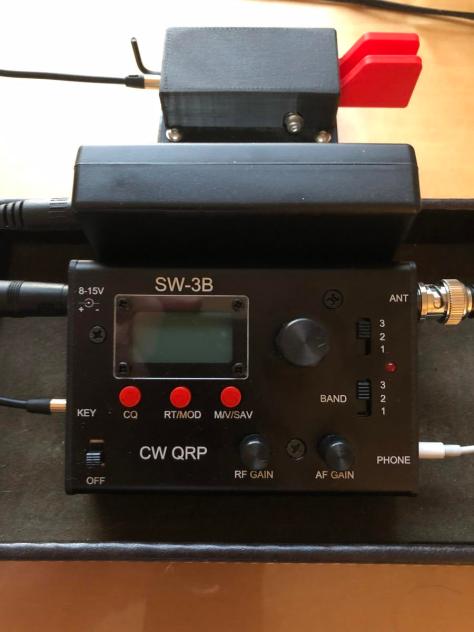 Many thanks to Dan (KE0ZAR) who writes:
Many thanks to Dan (KE0ZAR) who writes:
Hi Tom,
I just finished watching your video on resonant/non-resonant antennas and ATUs. I enjoyed it a lot.
For context, I got my ticket in 2020 and got on the air at the end of July 2020. Since that time I have only worked QRP CW using a QCX (the original) on 20 meters and then after September 2021, I got a Venus SW-3B so I have done a bit of work on 40m and 30m now as well.
I really enjoy the challenge of QRP and in a bit over a year, I worked all states, as well as Japan, Canada, several Europe countries, etc, so with good band conditions, QRP really does work and is a lot of fun. My experience working /P stated when I got the SW-3B but I only got out 3 times as the weather up in the hills west of Denver got too chilly very fast; this spring I’ll get back to more /P.
You can see my setup [above]; it is very minimalistic. My three antennas for 40, 30 and 20m are all EFHWs, each about 24 feet above ground. I use the Pacific Antenna SOTA tuner to match impedance both at home and in the field; its very small and packable and with its bridge circuit, I can get a good match at various deployments.
I thought I would share with you my experience and comments about the SW-3B radio; not a boring list of its features. Specifically, what my QCX lacked as AGC and an RF gain control. After way too many ear blasts from the QCX from strong signals, I absolutely love having AGC on the SW-3B. Perhaps more important though is that SW-3B has an RF gain control. While it certainly helps with strong nearby stations, it really shines in boosting the S/N of very weak stations by dialing down the RF gain and compensating by raising the AF gain. I am astounded how well this works and wonder how many more stations I might have worked on the QCX had it had this ability.
One other point that you will not discover on the Venus website or in the radio’s outdated documentation: the radio now can store a message for sending (with limitations), not just a callsign. Also, the radio now displays a power bar graph when transmitting. Both of these features became available in September 2020. I am guessing that the new Firmware that enables this is similar to the SW-3C model.
The one issue that I have had with the SW-3B is that the variable encoder became faulty after 3 months of operation. Specifically, rotations of the encoder resulted in unpredictable frequency changes so this messed up band scanning, zero-beating and tuning in off-frequency replies. I’ve read on QRZ that at least one other person had this issue.
My radio is now on its way back to China for repair and I hope that the radio lasts longer after the fix. Other than this issue, I love the SW-3B and wanted to pass this information on to you in case you were interested.
Thanks again for the nice website, articles and videos!
73,
Dan – KE0ZAR
Thank you for sharing this, Dan. Very impressed that not only did your journey start with QRP and CW, but you built your first radio! Wow! And then to grab your WAS and log DX? Most impressive.
Thank you for sharing your experience with the SW-3B as well. I’ve heard that Venus customer service is responsive and helpful. I see one of these transceivers in my future.
Thanks again!




These Chinese rig use cheap plastic parts like plastic rotary encoders. You can, replace them with metal ones which are a bit more reliable. They are not environmentally sealed so moisture and dust can get in.
Other than military radios like the Clansman RT320 you might want to consider the SGC SG2020 or Icom IC-7200. These are quite a bit more resilient.
If you are going to play rough with your toys, you better start learning how to service them yourself.
Having owned the SGC 2020 moons ago I wouldn’t wish it upon anyone. It’s a bit like the Commradio CTX-10. On paper it looks fabulous and robust. In practice, they’re both mediocre radios at very best. Both overload easily. The SGC has very poor audio and CW keying is frustrating. It does look cool though!
Keep in mind that many companies use plastic encoders on these portable radios to extend the life of the encoder. The aluminum ones while light are often larger in dimension and cause more stress on the actual encoder. This is why the KX2 has a plastic knob on its optical encoder.
The 7200 is nice (very nice, in fact) but quite heavy for portable operations.
Hi Dan. I have recently rediscovered QRP and I am having a blast with it. For POTA, I mainly use CW. If you decide to upgrade your rig, there are many fine choices out there. I also agree with you using RF gain. I use it all of the time and I set my AGC to fast. I have worked you once and hope to catch you again. Don’t forget to have fun.
Hello Thomas & Dan,
Chinese radios get a lot of bad press – deservedly so, in many cases, either due to poor performance or issues related to the illegal cloning of products.
The SW-3B does not fall into this category. Only 3 bands but a great little performer and super lightweight. I sold mine when I bought a mcHF – big mistake.
Yes, these rigs are great way to get into QRP. Can learn if for you or not, if not have not spent a lot. But they do work well, shows does not take much to have fun and make good long distant QSOs. And since have to build or put together a station you get that pride of doing much of it yourself.
CW does make it easier to make QSOs, but can have fun with SSB or digital/FT8/PSK31/RTTY.
Suggest go with 20 & 40m. These bands are open most days, 40m most all of the day. Do research on antennas, does not take much to make something that can perform well.
Once you get into QRP there are many rigs to choose from if want to upgrade.
73, ron, n9ee/r
I’m new to ham radio- just got my tech and general license. But now learning cw and thinking of buying this. Just need some guidance on antennas and a key? Thanks for any help u can give me!
Hi, Susan,
I’m about to post a recap of a SOTA activation I did yesterday with the SW-3B.
I can say that I’m very fond of CW Morse paddles. They work well and are affordable. Also, I love any/all keys made by N0SA–they’re great portable precision paddles.
In terms of antennas, I love end-fed half-ways (along with the vast majority of field operators). A 40M EFHW is resonant on 40 and 20 meters. The SW-3B also has 30 meters, though. Vibroplex does sell an end-fed half-wave that’s designed to also work 30 meters (you must lower the antenna briefly to modify it).
Good luck on your journey and I look forward to working you in the near future!
Cheers,
Thomas
K4SWL